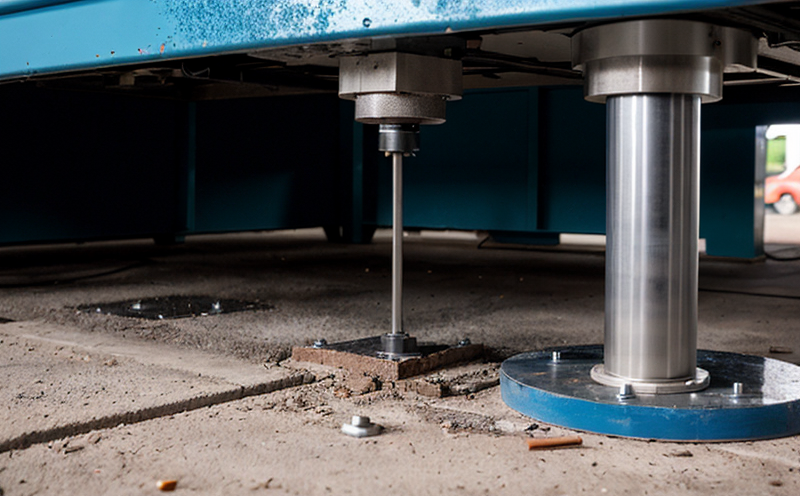ASTM E915 X-Ray Diffraction Residual Stress Measurement for Steel
The ASTM E915 standard provides a robust method for quantifying residual stresses in steel components using X-ray diffraction. This non-destructive technique is particularly valuable for quality control, ensuring that manufactured parts meet the stringent stress criteria set by industry standards and customer requirements.
Residual stresses in steel can arise from various processes such as forging, casting, welding, heat treatment, and machining. These internal stresses can significantly impact a part's performance, durability, and reliability. By measuring these stresses using ASTM E915, manufacturers can identify potential issues early in the production process and make necessary adjustments to improve product quality.
The technique involves directing X-ray beams at the sample surface, which causes diffraction patterns based on the crystal structure of the material. The diffracted X-rays are then analyzed to determine the orientation and density of the crystal planes, providing insights into the internal stress state of the steel component. This information is crucial for ensuring that parts meet specific design requirements and operational criteria.
The ASTM E915 method offers several advantages over other residual stress measurement techniques. It provides high spatial resolution, allowing for precise identification of stress gradients within a sample. Additionally, it can be used on complex geometries without the need to prepare large samples, making it highly versatile for various industrial applications.
For quality managers and compliance officers, ASTM E915 is an essential tool in ensuring that manufactured parts meet stringent stress criteria set by industry standards and customer requirements. R&D engineers can rely on this method to optimize material properties and design processes. Procurement teams benefit from the ability to verify supplier claims regarding the residual stress characteristics of materials.
The ASTM E915 standard is widely recognized for its accuracy and reliability, making it a preferred choice among manufacturers across various sectors including aerospace, automotive, and medical devices. The method's non-destructive nature ensures that critical components can be tested without compromising their integrity or performance.
Typical applications of ASTM E915 include:
- Quality assurance in manufacturing processes
- Detection of stress-induced cracks and failures
- Optimization of heat treatment and welding procedures
- Evaluation of material properties for new product development
The process involves several key steps, including sample preparation, X-ray beam alignment, data acquisition, and analysis. Proper specimen preparation is critical to ensure accurate stress measurements. Specimens should be polished to a high finish and free from defects that could interfere with the X-ray diffraction pattern.
Instrumentation used in ASTM E915 includes specialized X-ray diffractometers capable of precise angle measurement and data collection. Data analysis typically involves software tools designed to interpret the diffraction patterns and calculate residual stresses based on known crystal structures.
The acceptance criteria for ASTM E915 results are stringent, with specific tolerances defined in the standard. Compliance with these criteria ensures that parts meet the required stress levels specified by design engineers and customers.
Applied Standards
| Standard | Description |
|---|---|
| ASTM E915-18 | Standard Practice for Measuring Residual Stresses by X-Ray Diffraction |
| ISO 6469-2:2017 | Non-destructive testing of metallic materials - X-ray diffraction methods for measurement of residual stresses in metallic materials |
| EN 548:2002 | Residual stress by X-ray diffraction |
Eurolab Advantages
At Eurolab, we specialize in providing comprehensive testing services tailored to the unique needs of our clients. Our expertise in ASTM E915 X-ray diffraction residual stress measurement for steel ensures that our clients receive accurate and reliable results.
- Expertise and Experience: Our team comprises highly skilled engineers with extensive experience in ASTM E915 testing.
- State-of-the-Art Facilities: We offer advanced X-ray diffractometers that meet the highest industry standards for precision and accuracy.
- Comprehensive Reporting: Our detailed reports provide a comprehensive overview of residual stress measurements, including graphical representations and comparative analyses.
- Custom Solutions: We work closely with clients to develop tailored testing protocols that meet specific project requirements.
- Regulatory Compliance: Our services are fully compliant with international standards, ensuring that our clients meet all relevant regulatory requirements.
By choosing Eurolab for your ASTM E915 X-ray diffraction residual stress measurement needs, you can be confident in the accuracy and reliability of the results. Our commitment to quality and client satisfaction is unmatched, ensuring that you receive the best possible service.





